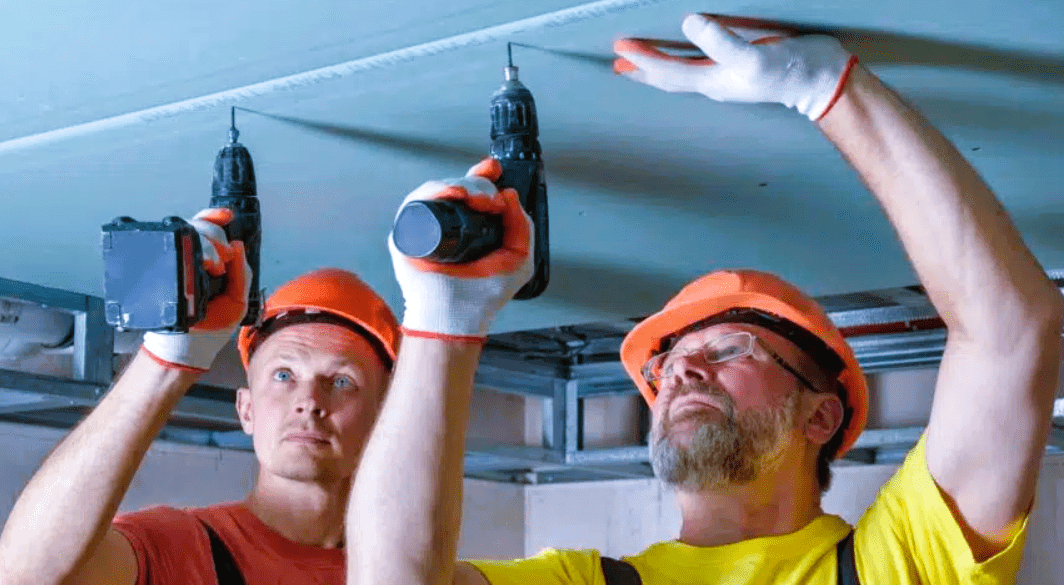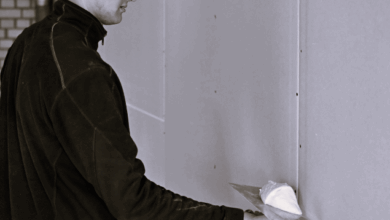Greenboard on Ceilings

Greenboard is famous for its water-resistant qualities. Unlike conventional drywall, the greenboard’s thick paper coating guarantees that moisture does not penetrate.
Greenboard is frequently utilized on the walls of high-moisture areas like bathrooms and kitchens because of this quality. But can ceilings support greenboards? We will cover that in the article for today.
Greenboard’s Viability on Ceilings
Ceilings can employ greenboards. Its installation and longevity depend on particular care and attention, nevertheless. Unlike conventional drywall, greenboard is somewhat weaker and far heavier.
So, using greenboard on a ceiling increases its failure risk. Later in this post, I will be guiding you through a step-by-step instruction on how to properly put a greenboard on a ceiling.
The bottom line, though, is that greenboard works on ceilings. Mostly in showers or kitchen ceilings with moisture issues, it is mostly employed.
Understand the Installation Risks
Before we get much deeper into this essay, I think it vital for you to know about the hazards connected with using a greenboard on a ceiling. Knowing these problems will enable you to choose wisely.
It is not waterproof.
Using greenboard on a ceiling has the greatest danger directly connected to its principal characteristic, water resistance. Indeed, the greenboard resists moisture. It is not, however, waterproof.
Eventually, the greenboard will become damaged or moldy if you use it in a shower or kitchen ceiling where moisture is always present. This issue is unavoidable.
It’s weighty.
Another drawback of putting greenboard on a ceiling is its great weight. Excess weight could put greater pressure on the framing of your ceiling. Therefore, strengthen the structural strength of the framing before putting a greenboard on a ceiling.
The Ceiling Greenboard is Prone to Sagging
Of all ceiling materials, Greenboard is most prone to sag. Weight, poor installation, or not utilizing fasteners at the required spacing all contribute to this.
Many earlier complaints from homeowners have been about greenboard sagging when applied on ceilings.
Painting greenboard on a ceiling is really challenging.
Painting or finishing such a surface is challenging because of the paper layer on the greenboard. Therefore, if you choose this material, be careful to properly prepare the surface for painting.
Greenboard is not fireproof.
Using a greenboard on your ceiling has one last disadvantage: it is not fire-resistant. This could be difficult if you want to raise the fire safety ratings of your home.
Installation Instructions by Steps
-
Step 1: Get the Ceiling Ready
You simply cannot begin screwing greenboard into the framing of your ceiling as it is really weighty. Begin by looking at the framing to determine whether it can support the extra weight. You may also change plumbing and electrical fixtures during this phase.
-
Step 2: Use Lumber to Strap the Ceiling
Though many people often miss this stage, I believe it is quite crucial since it streamlines the installation procedure. If at all feasible, strengthen the joists using 1″ x 3″ timber.
This will not only fit the extra weight. But it will let you secure the greenboard at a 12 inch gap rather than 16. This technique stops your ceiling’s greenboard from sagging.
-
Step 3: Cut the Greenboard into Smaller Panels
Now is the moment to put the greenboard on your ceiling. Start by calculating how much greenboard you will need. Then slice it to fit those dimensions.
-
Step 4: Fasten the Greenboard using Drywall Screws
Take the panels and begin screwing them into the wood. The screws should not harm the paper layer on the greenboard since it would render it useless. Simultaneously, you should make sure the panels are securely fastened.
Is It Code Compliant?
Sadly, 8 of 10 local building inspectors advise against installing greenboards on ceilings. The possible downsides I have already mentioned explain why.
The greenboard’s heavyweight and flimsy construction lead it to fail more often than other ceiling materials.
Local construction inspectors will advise other materials to help you avoid such problems.
You must verify the local construction codes before moving further with such a project. This will help you to avoid a great deal of disappointment, time, and money.
Improved Options for High-Moisture Areas
Up to now, it’s very obvious that greenboard is not the ideal ceiling material, especially for those exposed to excessive moisture.
Should you be curious in what materials do well in high-moisture ceilings, I have compiled a list of some possibilities to think about.
- Fibreglass-Reinforced Gypsum Panels: This is a gypsum panel reinforced with fiberglass to the core. Consequently, it is more resistant to damp and water than greenboard.
- Though not the most appealing material, PVC ceilings are completely watertight. No matter how much moisture a PVC ceiling is subjected to, it can last for years.
- One of the key greenboard substitutes is cement board. Its strongest feature is its water resistance and lack of quick deterioration.
- Metal Tiles: Very simple to clean, durable, and water-resistant are this material. So it’s the ideal substitute for laundry rooms or industrial kitchens.
How long-lasting is greenboard on ceilings?
On ceilings, greenboard is not the most lasting material. A greenboard can last from two to five years based on a conservative estimate. The caliber of the installation will determine that.
Your greenboard can last for far longer if you follow the instructions I have provided above. But I won’t deceive you.
In a few years, the greenboard will begin to degrade and you could see some sagging. Regrettably, this is not a simple solution. Your whole ceiling will have to be replaced.
Why Homeowners Continue to Use Greenboard
A little study will show you that, despite the several disadvantages connected with it, this is rather usual.
Do you question why greenboards are used on ceilings? Using greenboard on a ceiling has several advantages listed below.
- Unlike conventional drywall, greenboard will stop moisture from leaking through. That makes it perfect for ceilings in laundry rooms, bathrooms, or kitchens.
- The greenboard greatly limits mold growth by keeping moisture from flowing through.
- Installation is simple: The greenboard cuts readily since it is constructed of a gypsum core, which makes the installation process simple.
- Greenboard is a flexible material since it can be utilized almost everywhere in your house.
Not advised for outside use.
Greenboard is only permitted for internal use. It can be put in kitchens or bathrooms. Outdoor ceilings, including patios, cannot be installed with it. The greenboard is not waterproof, so remember that.
Direct exposure to rain or snow will cause it to degrade even more quickly. Should you want an outside ceiling material, please think about choices like fiber cement, vinyl, or exterior-grade plywood.

